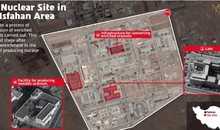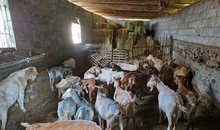
 Flash News
Flash News
Iran attacks Israel with ballistic missiles
"I wanted to do it...", the testimony of the Albanian man who killed his ex-wife in Italy is revealed
Two vehicles collide in Korça, one injured
Photo/ Mother of two children, who is the Albanian woman who was stabbed to death, was divorced from the perpetrator 3 years ago
Italy/ 45-year-old Albanian woman stabbed to death by ex-husband

Albania entered 2025 with an older population and further deepening emigration. According to official INSTAT data for January 1, 2025, the median age increased by 0.8 years within 1 year, reaching 44.3 years, while net emigration (emigration minus arrivals) reached around -29 thousand people. The population fell in 11 regions of the country, except for Tirana. Shkodra suffered the greatest contraction. If the country's demographic circumstances do not change, with the increase in births and the curbing of emigration, Albania risks falling below the 2 million population threshold before 2035. To mitigate the consequences of aging, the country's economy must grow by more than 5% per year, international institutions calculate
If the country's demographic circumstances do not change, with an increase in birth rates and a curb on immigration, Albania risks falling below the 2 million population threshold before 2035.
New official population data showed that on January 1, 2025, 2.36 million people lived in the country, a decrease of 1.8% from the 2023 Census.
The contraction of more than 27-30 thousand inhabitants per year, concentrated mainly in young people, risks taking the population indicator beyond any scenario and also makes solutions even more difficult.
In 2024, negative net migration doubled compared to the previous year with -28.8 thousand people from -13,761 people in 2023.
This rate of emigration has affected not only the total population size, but also its demographic structure, as young people and young families are the ones leaving the most.
In parallel with emigration, Albania has entered a long cycle of very low fertility at 1.3 births per woman.
This is reflected in a slight decrease in the youth dependency ratio, from 23.9% in 2024, to 23.8% in 2025 and accelerated population aging, while the old-age dependency ratio has increased by 2.2 percentage points between 2023 and 2025. Albania now has one of the oldest populations in the Balkans and Europe.
The median age of the EU in January 2025 was 44.7 years, while in Albania it was 44.3 years, according to the latest data.
The consequences are starting to be felt. The country has fewer young people entering the job market, and more older people are retiring.
Schools in entire areas risk closing due to a lack of students, and the administration and labor market suffer from a lack of human resources.
Demographers and economic experts believe that without sustained intervention, it will be difficult to keep the economy, pensions, and healthcare functioning.
For expert Ilir Gëdeshi, who has been dealing with the country's demographic developments for years, urgent policies are needed to curb emigration and others that promote birth rates in the country.
Births below the 2.1 limit per woman mean that each new generation is 40% smaller than the one retiring, putting the country facing the challenge of existence in this century.
The concentration of emigration at young ages directly reduces potential productivity because human capital with education and foreign languages is leaving, while increasing the pension burden for the residents who remain.
The higher life expectancy of 80.9 years for women and 75.3 years for men puts more pressure on pension and healthcare spending, while our country already has public spending per capita that is 34% of the EU average.
On the other hand, the average economic growth rate 2015 – 2024 is about 3.5% per year, not sufficient to narrow the gap with the EU.
The structure of the economy is dominated by low-productivity sectors such as agriculture, manufacturing, construction, and seasonal tourism. Public finances and the labor market are already under pressure.
For every year, the dependency of the elderly on the labor force increases by 1 percentage point per year and the pension scheme requires additional funding of 0.2% of GDP per year.
To mitigate the consequences of aging, the country's economy needs to grow by more than 5% per year, institutions such as the IMF calculate.
To mitigate the effects of aging, our country must invest in the remaining population, especially in digitalization, automation in agro-processing, grants in research and development, and create a favorable environment for the return of the diaspora.
If there are no changes in current demographic indicators, the SII deficit will double within a decade.
Unless action is taken now to increase the tax base, attract human capital, and modernize key sectors, the gap between rising age and economic well-being will widen, exposing public finances and long-term growth to systemic risk.
Albania enters 2025 with an older population, higher economic dependency, and still experiencing migratory losses. These developments are putting pressure on the labor market, public finances, and economic growth model.
Emigration focused on young people is reducing the young population and increasing the relative weight of the elderly.
According to projections, Albania will reach a median age of over 47 years within the decade, if the birth and migration trajectory does not change.
The increase in overall dependency means that for every 100 people of working age, there are now 57 children or pensioners.
This deepens the pressure on pension schemes and healthcare spending and worsens the contribution-benefit ratio./ Monitor
Latest news


Migrant agreements: What benefits Kosovo and why are they criticized?
2025-06-15 19:43:08
Gjirokastër/ Fire burns three hectares of grass near the Kardhiqi Bridge
2025-06-15 19:22:34

Gattuso appointed new Italy national team coach
2025-06-15 18:34:17
Over 400 people have been killed so far in Israeli attacks on Iran
2025-06-15 18:15:47
Trump warns of return to Kosovo-Serbia issue: Biden damaged it
2025-06-15 17:46:52
Bylykbashi: Current electoral system is toxic
2025-06-15 17:25:20
Trump vows for Iran-Israel deal, mentions Kosovo case with Serbia
2025-06-15 16:59:02
German tourist injured on Gjipesa beach, hit by a dinghy's propeller
2025-06-15 16:40:31

Iran attacks Israel with ballistic missiles
2025-06-15 15:48:49
Fecal beach in Durrës, the other side of the tourist miracle
2025-06-15 15:30:57
The attempt to constitute the Assembly in Kosovo fails again
2025-06-15 14:59:10
Ish-presidentit francez Sarkozy i hiqet medalja e Legjionit të Nderit
2025-06-15 14:58:46
Shkodra, with the highest population contraction after the Census
2025-06-15 14:31:47

Caused a fatal accident and left the scene, 35-year-old arrested in Lezha
2025-06-15 13:40:10


Rare! Whale appears near the Karaburun peninsula
2025-06-15 12:42:49

Stranded at sea, Border Police brings 8 foreign citizens ashore
2025-06-15 12:05:01
Who were the four Iranian generals killed in the Israeli attack?
2025-06-15 11:43:36

Simon Zereci is appointed head of the Republic Guard
2025-06-15 11:10:36
Gennaro Gattuso is expected to be the new Italy coach
2025-06-15 10:45:46
Two vehicles collide in Korça, one injured
2025-06-15 10:20:28
Trump says US can easily broker deal between Iran and Israel
2025-06-15 10:06:11


Italy/ 45-year-old Albanian woman stabbed to death by ex-husband
2025-06-15 09:16:43
Foreign exchange, the rate at which foreign currencies are sold and bought
2025-06-15 09:03:57
Horoscope, what do the stars have in store for you today?
2025-06-15 08:50:41
Albania risks falling below 2 million inhabitants before 2035
2025-06-15 08:30:11
Temperatures reach up to 32 degrees Celsius, weather forecast
2025-06-15 08:18:49
Morning Post/ In 2 lines: What mattered yesterday in Albania
2025-06-15 08:00:49

Two vehicles collide in Karbunara, one injured
2025-06-14 21:36:38
A person is found without signs of life in Peja
2025-06-14 21:18:19

Are you hungry after exercising? Experts recommend these snacks
2025-06-14 20:36:24

Kudos to Edi Rama for committing the May 11 theft in front of the cameras!
2025-06-14 19:57:21


These are the 3 most jealous zodiac signs
2025-06-14 19:01:29

Nesho: Iran is the violator of nuclear production
2025-06-14 18:21:43


A scrap metal collection point in Kavaja is engulfed in flames
2025-06-14 17:19:47
After Israeli attacks, Iran considers blocking the Strait of Hormuz
2025-06-14 17:02:28


Ja çfarë i ndodh organizmit tuaj nëse konsumoni çdo ditë limon
2025-06-14 16:16:23



Internationally wanted for corruption, Loran Dusha extradited from Zimbabwe
2025-06-14 15:30:04
VIDEO/ Dubai skyscraper engulfed in flames, 3,800 residents evacuated
2025-06-14 15:16:49
With these 5 ways, you can cope with the heat even at home
2025-06-14 15:08:46


Fire in Kavaja, a scrap metal collection point engulfed in flames
2025-06-14 14:43:40
Israel eliminates 9 scientists of the Iranian nuclear program
2025-06-14 14:33:34
The appeal of the GJKKO leaves the seizure of Arben Ahmetaj's assets in force
2025-06-14 14:17:14
Less appearance, more connection: How the way men love is changing
2025-06-14 14:16:13
Astrit Sinanaj is arrested in Tirana, he tried twice to kill a businessman
2025-06-14 14:02:59
Accident on Arbri Road, two foreign tourists end up in Trauma
2025-06-14 13:37:03




Tourist found dead inside apartment in Vlora
2025-06-14 12:46:40

Accident in Levan, truck with kitchen utensils ends up in the canal
2025-06-14 12:12:57

Clashes at the Order of the Psychologist, Treska declares the elections invalid
2025-06-14 11:45:55





The weekend brings luck for this zodiac sign, a pleasant surprise is coming!
2025-06-14 10:34:31
Caught with firearms and drugs in the car, two people arrested at "Ali Demi"
2025-06-14 10:25:17
Analysis: Israel's attack on Iran, ignition of conflict in the Middle East?
2025-06-14 10:16:14
Gambling in a bar, the owner and the waiter are arrested in Divjaka (NAMES)
2025-06-14 10:07:27




Tourist packages, how much does Albania "cost"
2025-06-14 08:58:23


From sun to clouds, what will the weather be like this Friday in Albania
2025-06-14 08:19:49
Morning mail/ With 2 lines: What mattered yesterday in Albania
2025-06-14 08:08:49
CEC decides to limit spending on local election campaign in Kosovo
2025-06-13 22:54:43
Israel confirms US support for the neutralization of missiles by Iran
2025-06-13 22:37:44
